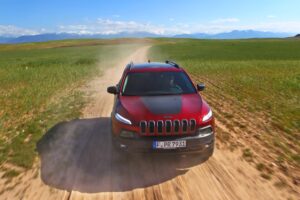
THE SHORT STORY:
The fact that a brand is well known is not the same as a strong brand. In the worst case, it can be quite the opposite. It can even be so bad that it is about to become degenerate and then the brand owner has lost financial opportunities the brand could have or even once had. It has become public property.
There are many such examples. “Thermos” and “Windsurfer” are forever lost to their former owners. But others have seen and understood – and been able to save their brand.
Tetra Pak is one such example and they care for their brand very carefully today.
Jeep was so degenerated, that it was impossible to register the brand in Sweden for many years. The then owner, DaimlerChrysler, had had to fight for a long time to establish the term SUV. When SUV finally was included in the Swedish dictionary, the brand could be registred.
Some brands, however, are so strong that they become icons.
And really strong brands can create a fortune for the owner who sells it. Like when Vin & Sprit (the Swedish alcohol company) sold Absolut to Pernod Ricard.
THE FULL STORY:
In a Facebook-group which I follow, there was recently a discussion about brands ”which are so well established that their name becomes the name of all products in the industry”.
But that description is based on a misunderstanding. If a brand becomes the name of all products in the industry, then it is about to become generic. Not well established.
Letting one’s brand become a part of the language is fatal.
Maybe the brand was first in its category, maybe it was really strong once. But the company failed to care for, develop and monitor it. The risk, then, is that it has degenerated and over time become public goods, without any real economic value to its owner. There are many such, sad examples over the years.
Words such as windsurfer, vespa, nylon and thermos were once trademarks but are now part of the general language. They have lost their distinctive meaning and become generic.
Ultimately, it is about protecting one’s own identity, explained Mats Urde, when I interviewed him a couple of years ago. He is a Doctor in Economics and associate professor at the University of Lund, as well as researcher and consultant in brand strategy.

The exclusive right to trademarks registered in the general language may be terminated. Then anyone can use them as any word and the risk of losing it is great.
According to Mats Urde, Tetra Pak was the first Swedish company that worked consciously to counteract degeneration. The company’s various brand names started to become general terms and in several dictionaries there are ”tetrapak” or ”tetra” with the designation for a certain type of cardboard packaging. Similarly, the ”jeep” became a ”small, off-road, four-wheel-drive vehicle” and ”vespa” briefly and well represents the category of scooters in the dictionaries.
But talking about generic brands is really a paradox, Mats Urde said. A strong brand is clear, unique and differentiated. A generic, on the other hand, describes a category. Then the specific characteristics that distinguish the brand are dissolved.
“If a brand is generic, it is no longer a brand. As a marketer, we want to create something that differentiates and positions a number of clear values and a clear identity. It is not a degree difference but a species difference,” said Mats Urde.
But not everyone sees generic brands as a problem. Many even think that it is an advantage if and when a brand becomes so famous that it becomes part of the language and appears in the dictionaries. Mats Urde doesn’t agree with that. He believes that this is rooted in a misconception about what a brand really is and what characterizes it strongly.
“If you think that the brand is strong when it becomes part of the general language, you will spend the entire marketing budget on cutting the branch you are sitting on. You undermine your own brand by promoting a category. ”
But he can see some benefits with degeneration. One is if one does not want to be known by their brand. He cited Freon, formerly a DuPont brand, as an example.
“Given the damage that Freon has done to the environment, it might be good not to be associated with such a product. But it is a unique case”.
Mats Urde believes that the risk of degenerate brands is greater in markets that sell everyday products, such as tape or plaster, or among different types of materials, such as Gore-Tex, nylon, teflon, Freon. When you are first, with a new product type or with products that pave the way for a new market, there is also a greater risk of the brand degenerating. If a new category designation for the product type is missing, it is likely that the particular brand name is used. Windsurfer was one such example. Unless otherwise noted, the product name was used to designate the category and eventually Windsurfer lost the exclusive right to its trademark.
“It would have been best to drop the brand and choose another one. It is probably easy to be gripped by the feeling that this is our market, that we have created it. But you can’t own the language. ”

In the case of Windsurfer, the company used a brand name that was just too descriptive, Mats Urde considered. It increases the risk the brand name becomes the general pitch. Companies that launch new products should therefore be careful to also find a generic product designation that works in all languages. Not just a new brand name. One must understand that a brand is a characteristic, he says. A simple typing rule is not to change the brand when using it in text, to not conjugate it and to always write it in uppercase letters.
“A few years ago, it was a trend to write brand names in lowercase. For brands that were becoming generic, it was unfortunate as they then merged into the text as any word and did not become distinctive as their own name.”
Tetra Pak was about to become a thermos
Tetra Pak did learn the lesson well. In the 1980s, the brand was about to become generic. But through intensive and conscious work, they were able to reverse development.
10-15 years ago I wrote an article, which also contained a brief reference to a product from Tetra Pak. Unfortunately there was a small a proofreading error in the text. Shortly thereafter, we received a letter with the headline ”Help us take care of our brand”. Kindly, but firmly, it was pointed out that the Tetra Pak mark had been treated incorrectly in our text. In addition, a brief description of how well spread the brand is, as well as information on how careful the company is to best care for its brand.
It can be described as a textbook example of brand care down to the smallest detail. It hasn’t always been that way, though. Not even for Tetra Pak. However, since the company realized the importance of its brands, they have worked intensively and consciously with their care.
Tetra Pak, originated in the early 1950s when Ruben Rausing developed a disposable liquid food packaging. The packaging quickly gained great success, both within and outside Sweden. But the risks came quickly. The company name was sometimes called ”Tetra” and Tetra Pak (packaging) slipped over to become ”Tetra Pack”, ”Tetra Packet” or ”Tetran” (the Tetra).
But not until the 1980s did they realize that it was a real danger. Then the competition became clearer and the plagiarism as well.
The company made a comprehensive inventory of brand use, both within the company and outside. It could then be stated that this was an international phenomenon and that the names of the two types of packaging, Tetra Pak and Tetra Bric, were becoming part of an international language.
The deep seriousness was evident when the 1987 edition of the Swedish Esselte dictionary was published. There, the brand was listed ”generic and in addition in an unflattering context: tet’rapak subst. = A tetrahedron (cardboard) beverage packaging (original brand): milk in *; many * was littered in the wild. ”
It became a real alarm clock and the company started hard work to regain its brand. But it still took about 20 years before you realized that this was not primarily a matter for the patent department, but that it should start a regular brand department.
Tetra Pak’s products are present in 175 countries and a total of 23,000 employees are active in 85 countries. Everyone is informed about the importance of Tetra Pak’s strong brand. And everyone has a pronounced responsibility to ensure that it is not abused. A number of years ago, a brand day was also held for all the Group’s employees. There, among other things, they received the (now digital) brochure ”Trademark – a user’s guide”. It provides all the information about what applies. And what, for example, is the difference between Tetra Pak’s trademark and its brand.
Everyone knows that Tetra Pak’s brand promise stands for ”Protect the good” – in the sense of ”food, people and future.”
In this way, everyone in the company is constantly informed about branding issues. Internal branding is carried out continuously under the slogan ”Trademarks means business, protect our trademarks”.
Tetra Pak will not risk degenerating its brand again.
Jeep had lost its grip from the start
Another company that was bad looking was Chrysler. Their brand, Jeep, had become generic before even being registered in Sweden.
These are examples of a brand that was first in its segment and became part of the language. It has a long history of degeneration and the worst has been in Sweden. For many years the word was included in the Swedish Dictionary as a general term for an ”off-road car”. The road to trademark registration was thus blocked. Any other company was free to call their products ”jeep”.

The then owner, DaimlerChrysler, was constantly fighting for the right to use their own brand as they wished and could not differentiate themselves from competitors and make customers understand why they should buy their car. They even had trouble registering the domain name jeep.se.
Until the turn of the millennium, Jeep was represented in the Swedish market by a general agent, but in January 2000 DaimlerChrysler took over the business itself. They then started an intensive effort to recapture the brand, among other things by constantly mentioning that there is only one Jeep. The advertisement stated that the Jeep was the original. The payoff “There’s only one” and the ® sign together with the brand name were visible reminders. With promotional efforts of various kinds, Jeep tried to persuade motor journalists to use the concept SUV for other off-road vehicles.
Finally, when SUV entered the Swedish Dictionary, it became possible to register trademark Jeep.
And famous is not the same as strong!
It is also a common misconception that a well-known brand would be the same as a strong one. It is not obvious.
Strong is the brand that creates direct and clear associations in the consumer’s head and heart.
Say Harley Davidson and dream of the ultimate freedom awakens in most. Whether you like motorcycles, or even imagine getting up on one at all.
And you can wake anyone in the middle of the night and get a definition of Volvo’s core values. 9 out of 10 answer ”security”.
But not even the most vigilant will find any direct associations around Opel, although most people are very familiar with the brand. It is a very well-known brand on the Swedish market, but not a strong one. That is one reason why Opel is losing market. In 2018, it reached a market share of 1.6 percent, and keeps falling. While Volvo remains as market leader at around 20 percent.
There are a small number of brands that are so strong that they have transitioned to icon status.
The concept was launched by American researcher Douglas B. Holt of Harvard Business School. He has mentioned brands like Harley-Davidson, Absolut, Nike and Apple as just icons. They manage to maintain a stable and strong position over the years.
Holt explained that the strategic focus is on what the brand stands for, not what it does and they have succeeded in building a value based on myths, which provides ideals we can live by.
Apple (like Harley-Davidson) has become strongly associated with freedom. The Apple-launch in the early 1980s was brilliant. Apple was the rebel who revolutionized information technology and made computers human. The fact that much focus was on humanistic applications such as text, image and music further strengthened the profile.
Today, rumors and speculation are buzzing wildly, with every launch of a new Apple product and the entire world press in place, as soon as Apple tells about a new detail.
Another very concrete example of the value of a strong brand is understood when Pernod Ricard paid SEK 55 billion to the Swedish state for the purchase of Vin & Sprit (Wine and Spirit Company). It was to get the Absolut icon, they were prepared to pay that sum. Everything else was just included.
Companies that have failed to build strong brands easily fall into the trap of lowering their prices, as that is the only real competitive advantage they find themselves seeing. Something that risks leading to a downward spiral, where market activities focus on price and product development to cut costs. But, over time, no price can be low enough.
A strong brand, on the other hand, can take market share and maintain or increase its price level and profit. It is also much better equipped when times get tough.


